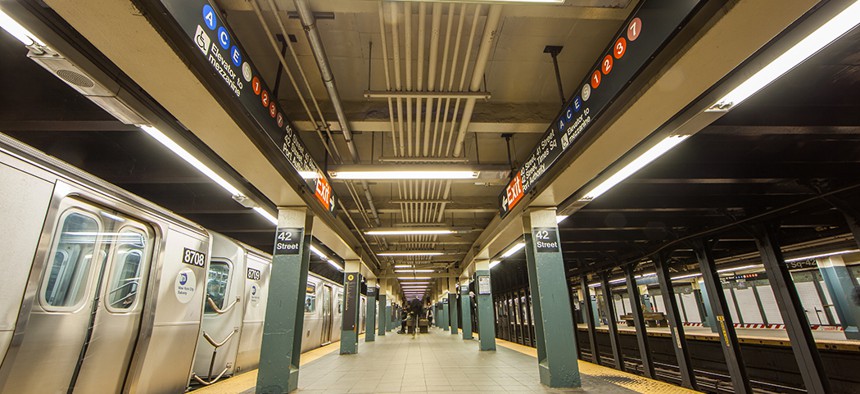Descending into the sweltering heat of New York City’s subway stations, like putting up with rush hour traffic, can seem like an inevitable indignity of life in New York City. But extreme heat is far more than a nuisance. High temperatures pose serious health risks to riders and subway workers and contribute to train delays from passengers who become ill. The elderly and infirm are most affected. Fainting and illness rise sharply when temperatures exceed 90 degrees, which they often do.
It isn’t just the weather that’s to blame. Subway stations in late summer are consistently hotter than even the sweltering streets above. On one recent and fairly typical summer day, Aug. 9, the 10 busiest subways stations ranged from 94 to 104 degrees while the outside temperature was only 86.
This is getting worse because of global warming. Heat waves are coming with increasing frequency and intensity and average annual temperatures increased 3.4 degrees in New York City between 1990 and 2013. Temperatures are projected to increase another 5 degrees by 2050, according to a 2015 report by the New York City Panel on Climate Change.
Rising temperatures are magnified by growing ridership, crowding, decaying subway infrastructure and the resulting erratic service. Most of the heat that riders experience comes from the enormous amount of energy needed to stop, start and speed up trains that can weigh up to 900,000 pounds, as well as hot air that air conditioned trains blow onto the platforms. Train congestion results in less efficient braking and acceleration, which generates even more heat. In many cases, old and dysfunctional ventilation plants worsen the problem.
Unlike the weather, oppressive station heat is something we have some control over. Other cities around the world are tackling the problem and achieving results. London’s ambitious Cooling the Tube program, for example, has reduced braking-related heat generation by 32 percent, and is using innovative cooling solutions tailored to particular stations, such as drawing up cool groundwater from London’s aquifer at one station and installing a chiller system at another that cools air drawn in from the outside.
In the short term, the Metropolitan Transportation Authority can only do so much. The system’s old subway stations weren’t designed with temperature control as a priority, much less for the heavy air-conditioned trains it handles today. Modest steps, like reducing heat-generating objects on the platform or reducing the extent to which trains are air conditioned, could give some relief on the platform while still keeping subway cars reasonably cool. But really cooling subway stations, as described in RPA’s June 2018 Save Our Subways report, will take time and money, just like most of the subway’s other systemic problems.
The good news is that some of the fixes that are most needed to restore reliability and handle growing ridership would also lead to cooler subway stations. Communication-based train control (CBTC), the upgrade to the subway system’s archaic signaling system that is a priority of the New York City Transit Authority’s proposed and much-needed Fast Forward program to rebuild the system over the next decade, would greatly improve the efficiency of slowing and accelerating trains, thereby reducing the heat generated in the process. CBTC would make train movements smoother, reducing the amount of braking that causes so much of the heat in the tunnels. Trains would also spend less time in the stations.
Other components of the Fast Forward program could also serve this dual purpose, if the MTA makes energy efficiency and heat reduction priorities. Upgrading existing subway cars and buying new ones represents another set of opportunities. Modern technology can create lighter subway cars, which run more efficiently and generate less heat. Open gangway trainsets, which allow passengers to move between cars, would be lighter and make it faster to load and unload trains, keeping them moving through the stations more quickly.
Station repairs and upgrades create other opportunities that may be possible at particular stations. Stations could reduce the heat given off by mechanical systems, for example, by switching to more efficient systems such as motion-activated escalators. For example, in 2009, the MTA Blue Ribbon Commission on Sustainability recommended investigating the use of pumped ground water to cool stations where feasible. This is essentially a scaling up of a “swamp cooler” where fans chill warm air by pumping it over cooler water.
One action that would make a big difference, not just for keeping the platforms cool but also for improving safety, noise and air quality, would be to install platform screen doors between the tracks and the platforms. This should be done anyway: As The New York Post reported in 2016, “Some 150 people – and climbing – are struck by trains each year, 50 or more fatally.” These barriers would not only prevent customers from falling or being pushed onto the tracks, they would also enable trains to enter and leave the station faster, reduce the amount of hot air blown onto the tracks, and allow for the installation of cooling and heating systems on the platforms.
Yes, these actions would add to the daunting costs of modernizing New York’s vast, aging subway network. But if we are serious about insuring that the system protects the health and safety of its customers and workers, especially those unable to afford other ways to get around, then they need to be a priority. Most leverage investments that are needed under any circumstances, and they will ultimately make the system more efficient and less costly to run, as well as help attract more fare-paying riders. Even as temperatures continue to rise, going below ground to board a train shouldn’t be a health-threatening experience.

NEXT STORY: New York should create affordable housing in the suburbs


